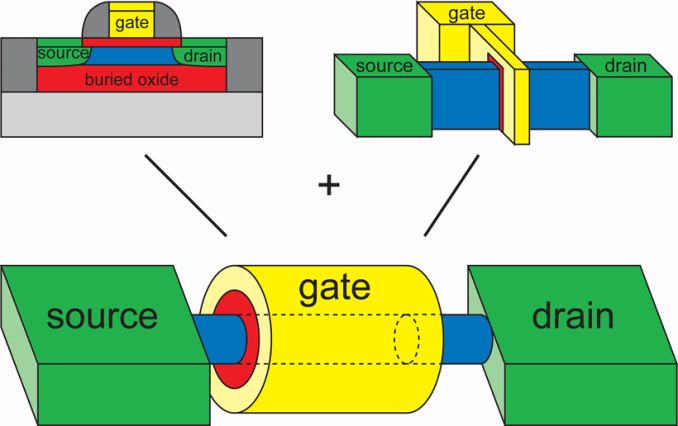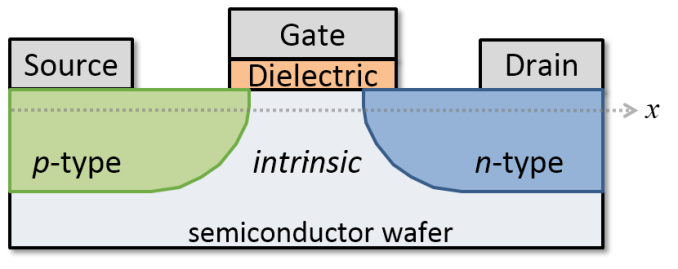An Introduction to Semiconductor Physics, Technology, and Industry
by Joshua Ho on October 9, 2014 3:00 PM EST- Posted in
- Semiconductors
- CMOS
- Physics
- Industry
- Technology
Improving Transistor Performance
While it's impossible to predict what the future will hold, it's relatively easy to see what trends will take place in the near future to keep Moore's law alive. For example, instead of using dual or tri gate technologies (FinFET), it's reasonable to expect that gate-all-around (GAA) will become the next step in the evolution of transistor shapes. However, it's currently not clear when this would reach mass production, if ever.
Currently, experimental GAAFETs have only existed for around eight years. For reference, FinFETs were first made in 1999. It took around a decade and a half for any such 3D transistor to reach mass production. By continuing to scale to higher k dielectrics for the gate, lower k dielectrics between interconnects, lower resistance metals for interconnects, and even better strain engineering, we will continue to see the scaling of CMOS technology.
CNFET / Joerg Appenzeller
Unfortunately, all of these can only go so far. Fundamentally, there will be a point where silicon-based transistors cannot scale any further. Gate oxides, channel lengths, and other critical dimensions can only shrink so much before either resistance is too high or a myriad of other effects render smaller sizes infeasible.
The next step is almost impossible to predict. Perhaps graphene will take the place of silicon, but graphene currently is impossible to mass-produce and is a semi-metal, which means that it inherently lacks a band gap, although it's possible to create one. While it's been shown that semi-metal transistor logic is possible, it's currently in the very early stages and Boolean logic may be impossible with graphene. Phosphorene has promise as a semiconductor replacement for silicon, but it's similarly impossible to mass produce. Phosphorene-based FETs are still in the exploratory stages, with no actual transistor created yet.
TFET Lateral Structure / Jteherani / CC BY SA
Outside of material changes, the working mechanism of the transistor itself may change. One promising candidate right now is the tunnel field effect transistor, which relies on band to band tunneling rather than the traditional inversion layer generation for current flow. This is similar to leakage that occurs from halo doping, which results from the conduction band of the channel material aligning with the valence band of the source or drain material. As seen by the photo above, this type of transistor has an undoped body and the source/drain are of opposing types. The gate structure is unchanged from previous MOSFETs. In practice, such a transistor structure has a much higher rate of current increase per unit of voltage.
Final Words
It's been a long road, but let's quickly go over the topics covered in this article. We started with a description of semiconductor physics, then moved to the basics of MOSFETs and CMOS. Once we understood how MOSFETs work in CMOS to create logic, we moved on to the actual fabrication process of these transistors in a chip.
After all of this, we discussed how companies have increased the resolution of the fabrication process to make ever smaller transistors, and we continued by looking at how companies have increased transistor performance despite significant engineering challenges. Then we briefly covered what the future may hold for improving device performance and continuing to improve the lithography process to continue making smaller transistors.
But there is far more to be done, as literally everything we write about at AnandTech depends upon ever faster, smaller, and more efficient transistors packed as tightly as possible. Without this continued innovation, the PC, smartphone, and wearables that we see today would be impossible to make. However, continuing the scaling that we have seen within the past decades will require more ingenuity and resources than ever before to continue pushing the limits of what's possible.
Normally, we would end things here, but this time I'd like to end by thanking everyone that has helped make this article possible. It has taken weeks of research and asking questions to get to this point, and I'm sure that without help it would have taken months. Out of the many that have helped, I'd like to specifically thank Chenming Hu, a professor in the graduate school at UC Berkeley and the lead researcher in FinFET and UTB-SOI/FD-SOI, for taking the time to help clarify the reasons for SOI and FinFET. I'd also like to thank Gerd Grau, a doctoral candidate in the graduate school at UC Berkeley, and Intel's TMG for answering all kinds of questions about solid state physics in general.












77 Comments
View All Comments
dragonsqrrl - Thursday, October 9, 2014 - link
Article like non other, thanks.tarlinian - Thursday, October 9, 2014 - link
The description of the wafer processing is pretty much completely wrong. FEOL line processing involves almost no direct oxide etches. It also completely skips shallow trench isolation and all the CMP steps involved in patterning. The wiring of the chip has no metal etch anymore either. Every metal layer in a modern (<10 years old) logic chip is produced via damascene patterning of copper. (You etch a dielectric, fill the trenches with copper and then polish the copper back.)JoshHo - Thursday, October 9, 2014 - link
Much of the article is definitely quite simplified but the intent is to give a general idea of the process. I'd love to learn about this subject in more depth though.revoltracers - Thursday, October 9, 2014 - link
I am printing this one out.tuxRoller - Thursday, October 9, 2014 - link
Could you expand on "the holes in the p-type and the electrons in n-type are all pushed towards the junction, which causes the depletion zone to shrink" a bit?Connecting the + terminal @ the p semiconductor means you'll get electrons flowing into the n semiconductor. This should result in the n semiconductor being even more relatively negative, and the opposite on the p semiconductor.
If that's the case, why wouldn't that cause a larger delta V at the junction?
JoshHo - Friday, October 10, 2014 - link
The issue here is that there is a diffusion of charge carriers. The negative end provides the potential that pushes electrons towards the depletion layer on the n-side, which has holes due to the diffusion that was previously discussed. The positive end pushes holes towards the center on the p-side, which has electrons in the depletion region.tuxRoller - Friday, October 10, 2014 - link
Damn.IOW, I got my field directions mixed.
Thanks.
dyc4ha - Thursday, October 9, 2014 - link
Thanks! I am still trying to digest this article, but nevertheless I know I am enjoying it! Keep it goingPacificToast - Thursday, October 9, 2014 - link
Nice piece. It's great to see easily accessible high-level articles being written on micro-nano IC tech. I work for a large foundry, and its often hard to explain to people what's happening inside their devices.Dr.Neale - Friday, October 10, 2014 - link
First, a minor typo appears in the High-k / Metal Gate section, 3rd paragraph, 1st sentence: "comlexity" should be "complexity". (Amazing that in an article of this complexity I could only find one typo!)Second, I noticed that there was no mention of compound semiconductors like GaAs. I was under the impression that while many technical issues have been resolved, it remains prohibitively more expensive than silicon. Is this indeed the case, or are other factors more of an issue than cost?
Great article, by the way, especially in regard to FinFET transistors. Makes things much clearer in my mind.
Thanks, Josh.